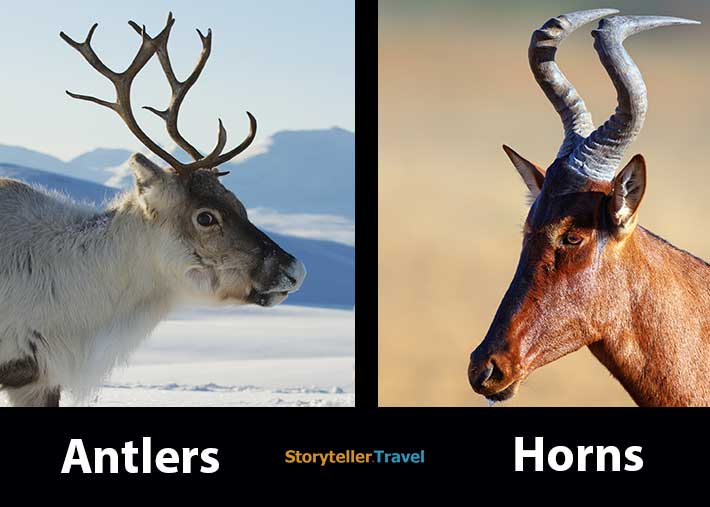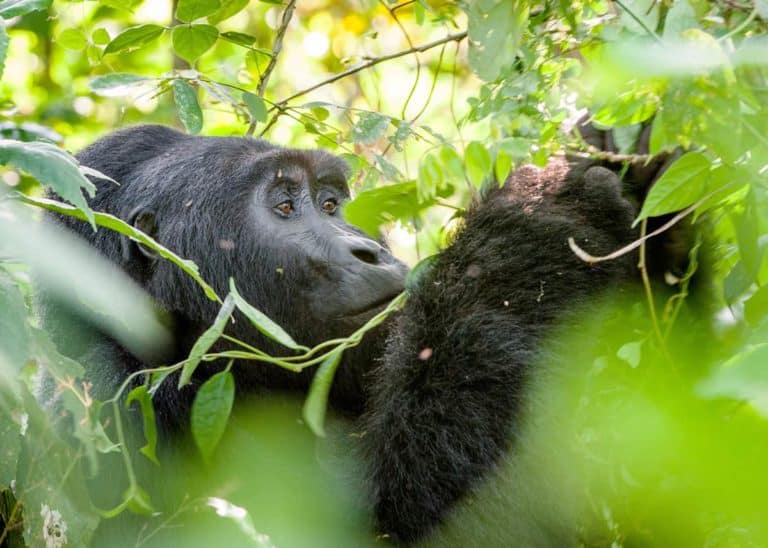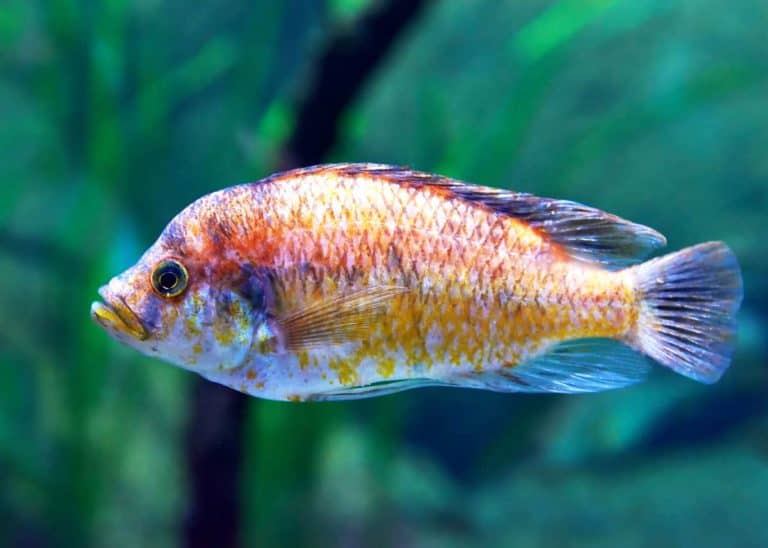Antlers vs Horns: 6 Differences (Made of, Purpose, Gender)
Many mammals have horns and antlers. What are the differences between antlers vs horns? Here are the key differences between antlers and horns. Plus other animals with horn-like growths. And the largest horns and antlers on the planet.
Horns and antlers are different. Antlers are a bone that is regrown each year. Horns grow throughout an animal’s lifetime and are made of bone and a covering a similar material to human fingernails. Horns exist on antelope and bighorn sheep, while antlers exist on deer species. Horns and antlers have different shapes and purposes.
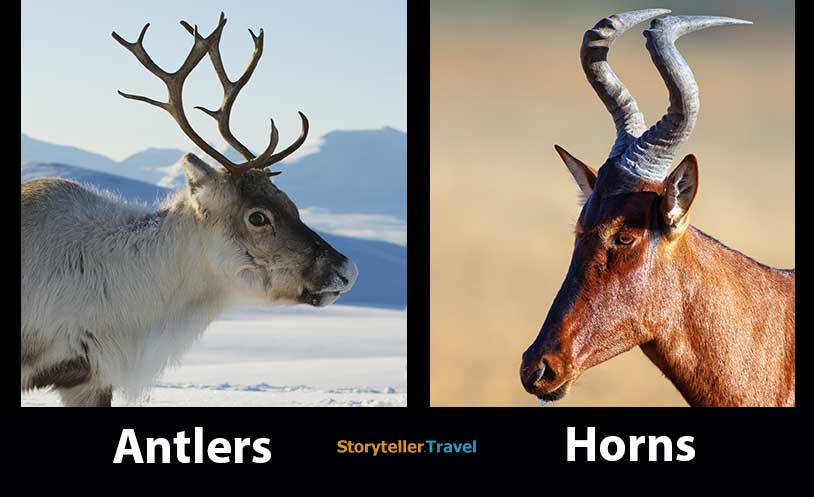
Horns and antlers are made of different materials, grow and exist for different amounts of time, and serve different purposes.
They are also found in different animals and have different shapes and sizes.
Knowing the characteristics is helpful in identifying them.
The terms horn and antler are often used interchangeably. You might be surprised to learn which animals have horns and which have antlers.
Let’s dive into these key differences and see how horns and antlers compare.
1. Distinct Taxonomy
Horned animals are classified into two families. And animals with antlers are classified into a distinct family.
What animals have antlers? Antlers are skull extensions in members of the deer family (Cervidae). Typically antlers are only found in males.
What animals have horns? True horns are found in the Antilocapridae (pronghorn) and Bovidae (cattle, goats, antelope etc.) families. And they mainly include the ruminant artiodactyls.
Here are some examples:
| Animals with Horns | Animals with Antlers |
|---|---|
| Pronghorn | White-tailed deer |
| Bighorn sheep | Elk |
| Bison | Moose |
| Antelopes | Caribou (Reindeer) |
| Cows and sheep | Barbary stag |
While these animals are classified as having horns or antlers, there is some uniqueness among each group.
For example, a pronghorn sheep has horns, but like antler-growing animals, it sheds the hard shell of its horns every year while most horned animals maintain their horns and outer shell throughout their lifetime.
And not all deer grow antlers. Water deer grow fangs instead of antlers.
2. Gender Differences
Horns: Among animals that grow horns, both females and males have horns.
Antlers: Among antlered animals, only the males grow antlers. We’ll learn more about why later in the post.
As with most taxonomy, there are exceptions.
- Caribou (reindeer): Both the females and males grow antlers.
- And in rare cases, female white-tailed deer can sometimes grow antlers. They have been described as pseudo-hermaphrodites and it attributed to high testosterone levels.
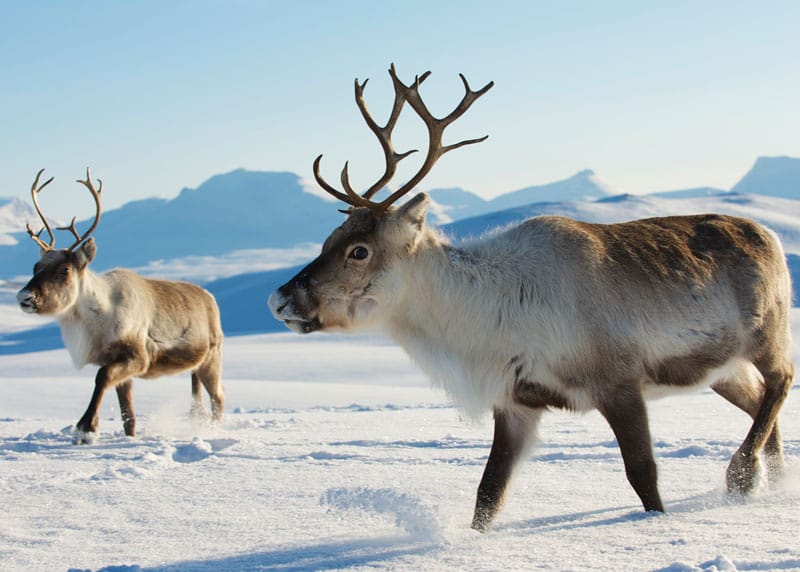
3. Purpose of Horns and Antlers
Animals use horns and antlers differently.
Horns: Since bighorn sheep and bison keep their horns their entire life, they are often used as a means to claim their territory and help the animal to fight off predators or unwelcome suitors.
They can be used all year round and so they acquire many different purposes and uses.
Bison will often use them to headbutt other bison as an act of bravery or they will use them to protect them against predators that may be threatening them. Since they have them all the time, their purposes are wide and are a critical part of their everyday life.
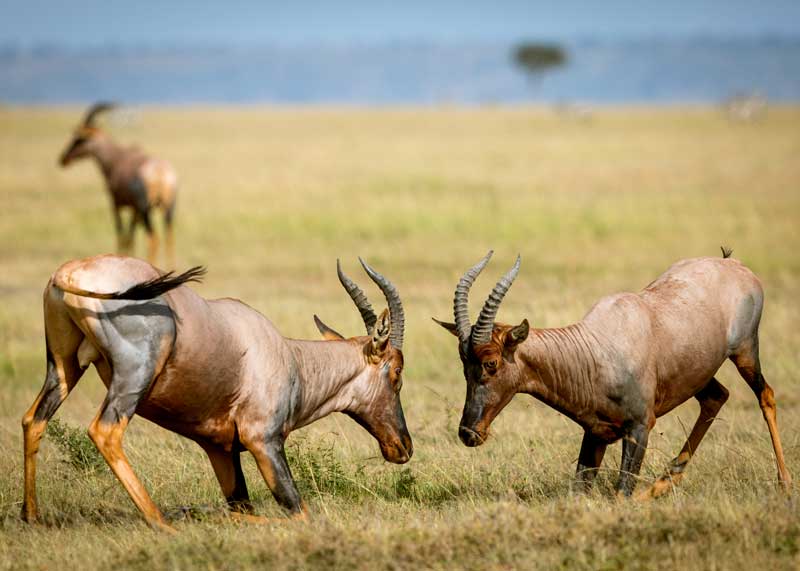
Antlers: Their primary purpose is the attraction of females and as weapons during battles between males.
They are the hardest, biggest, and most useful right during a time called the rut when deer and other similar species are in prime mating time.
Because antlers grow, fall off and regrow on an annual schedule, we can note the specific purpose.
Therefore, their purpose is to fight off different bucks (bulls) so that they can be the winners of the doe (cows). They will fight for their breeding right and will do so each year when they get their new horns.
They will shed their horns in the winter when they aren’t needed.
4. Shape of Antlers vs Horns
Antlers often look like branches on a tree. They have many different tines and points that make up the antler as a whole. This way they can interlock and be used to fight against other antlered deer.
Most horns have one point and either twist and spiral or face opposing directions. Horns are a permanent, curved or spiral projection, often with fluting or ridges.
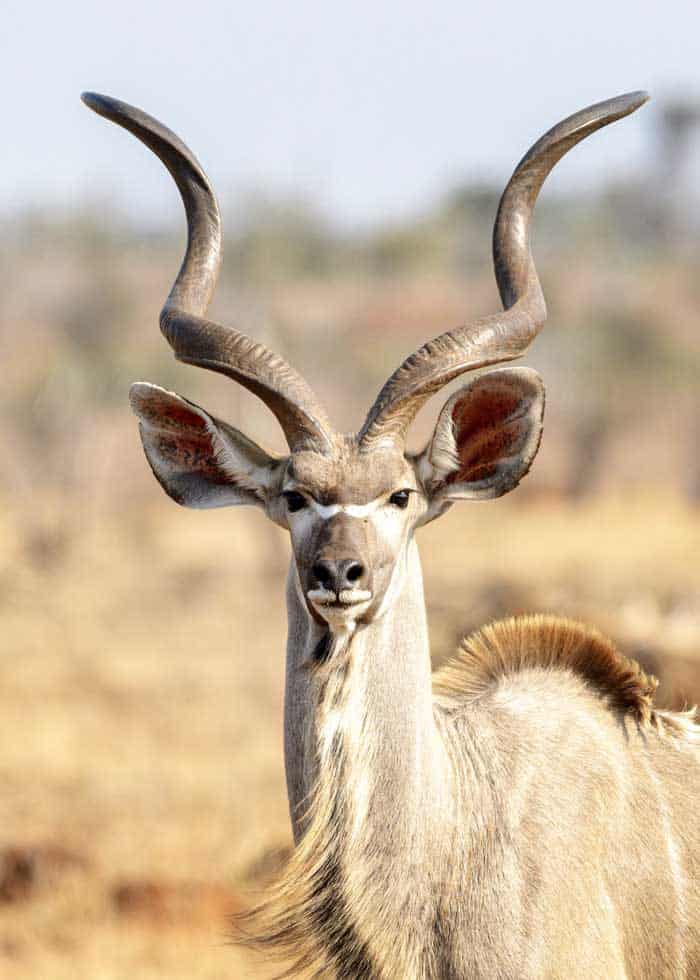
This is one of the many ways you can tell the two apart. Antlers will have many points and tines, while horns will primarily only have one point or tine with the exception of the pronghorn which has branched horns.
5. Structure
Antlers and horns contain distinct materials. This is one of the main differences that characterize the two separately.
Horns: They are protruding bone that is covered in a thick layer of keratin the keeps it strong and incredibly durable. This is the same material as human nails.
These continue to grow throughout their lifetime, getting stronger and larger. Over time, they develop a thick outer shell to cover the bone. Horns grow from the base.
Antlers are an extension of the animal’s skull. They are a single structure – containing bone, cartilage, nerves, skin and blood vessels. Antlers grow from the tips, extending each tine more and more rather than the entire horn.
Antlers start outgrowing as more cartilage hardens into a spongy bone over the growing process.
When horns are still in the growing process they have a soft velvet covering them which allows them to continue to grow and have circulation. After they have finished growing the velvet is either scraped off or falls off.
6. Growth Patterns
Antlers grow once a year for the mating season which is late fall. They will lose their horns in the winter and then start re-growing them every spring.
They reach their peak regrowth in the late fall and then start the entire process over again every year. Their horns will still grow larger each year, making them normally a superior threat even to horned animals.
Horns grow continually over the life of the animal. They begin growing early in the animal’s life and will keep growing until they are old and break off.
They gradually get bigger over time and become strong for the animal to use. They start growing at birth and do not quit until they die. If they do get broken, over time they will slowly grow back.
Common Questions About Animal Horns and Antlers
8 Other Animals With Hornlike Growths
Here are some animals with horn-like growths, but don’t fit the scientific description of horns.
- Giraffes
- Rhinoceros
- Golden Jackals: This small wolf can sometimes grow a half-inch, cone-shaped bony growth on its skull.
- Chameleons
- Rhinoceros Beetles
- Horned Lizards
- Horned Screamer: This South American bird has a spiny structure on its skull.
- Dinosaurs: Triceratops, Shringasaurus
5 Mammals with Tusks
While having a similar appearance to horns, tusks are actually large teeth.
- Elephants
- Narwhals: This might be surprising, because it appears to have an antler coming out of it’s head. According to Everywhere Wild, the “horn” is acually a tooth that grows through it’s upper lip. It can grow up to 8.8 meters long.
- Walruses
- Wild boar
- Musk deer (Moschidae): These even-toed ungulates are distinguished by long saber teeth, or fangs.
What’s the Only Mammal Born With Horns?
Baby giraffes are the only mammal born with their horns. They aren’t attached to the skull at birth and lie flat. This protects the mother from injury during delivery.
But, giraffe’s “horns” are actually called ossicones. They are formed from ossified cartilage (cartilage that has hardened into bone) and are covered in skin.
Sharks have something similar to giraffe’s quasi-horns. Rather than having bones, sharks have calcified cartilage that has bone-like characteristics.
Longest Horns
At 13 ft 10 in (4.24 m) an Asian water buffalo has the longest recorded horns of any living animal. This is the measurement from tip to tip, across the forehead. It was recorded in 1955.
This is longer than the average Asian water buffalo horn spread of 3 ft 3in (1 m).
Among domesticated animals, a Texas longhorn steer recorded a horn spread of 10 ft 7.4 in (3.23 m)
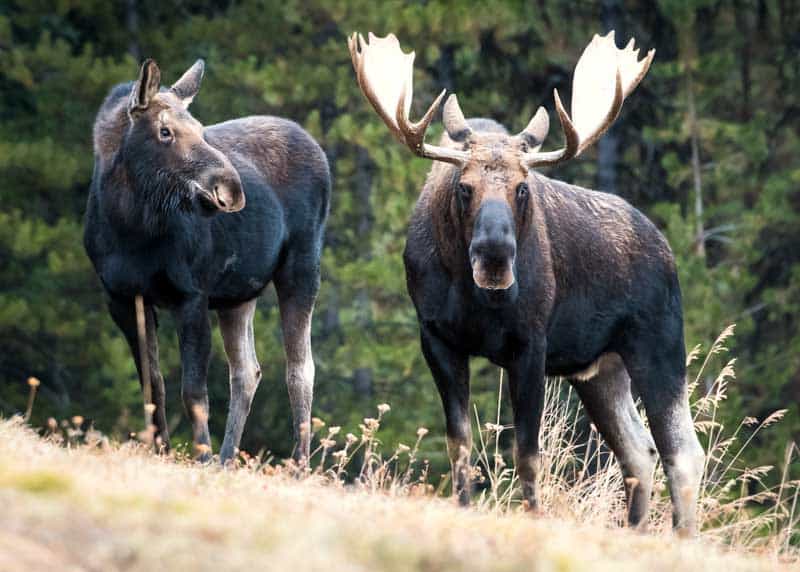
Biggest Antlers
At 6 ft 7 in (2 m) a moose has the largest antlers of any living animal. The widest moose antler spread was 6 ft 11 in (83 inches). Moose antlers weigh around 40 lb on average.
The heaviest antlers on record belonged to an Alaskan moose and weighed 79 lb (36 kg).
Among extinct animals with antlers, the record goes to the Irish Elk (Megaloceros giganteus). Its horns measured 12 feet across and weighed almost 90 lb (41 kg). And while it is named an elk, it was actually a giant deer.
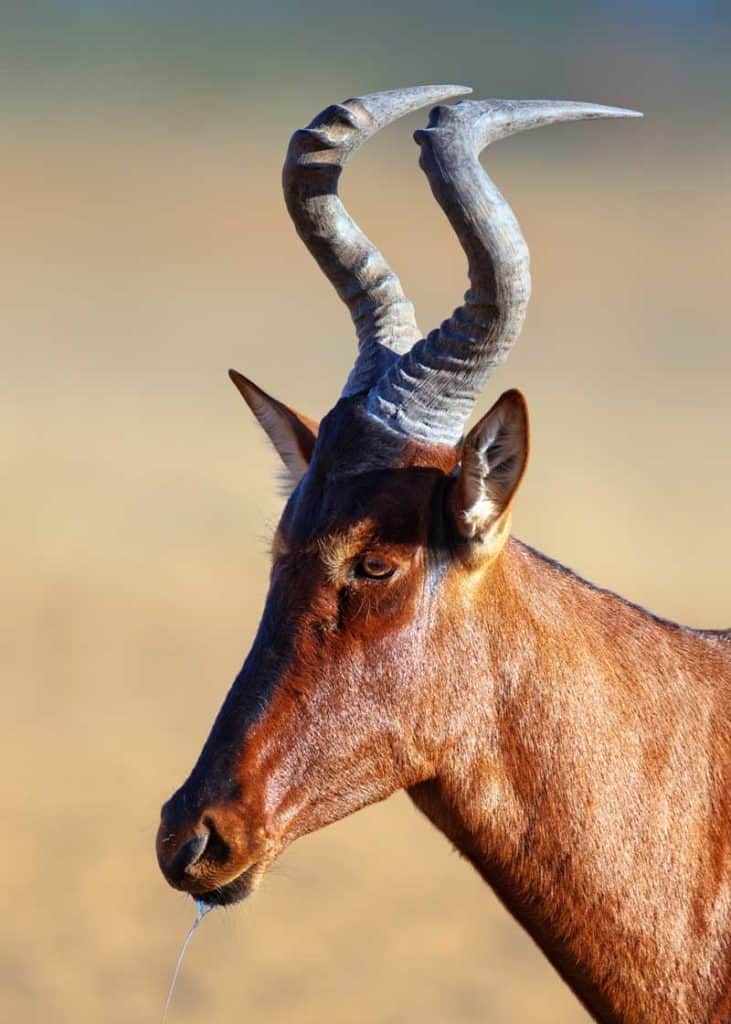
Your Turn
Have a question about horns vs antlers? Or maybe a fact or story to share? Let me know below!

